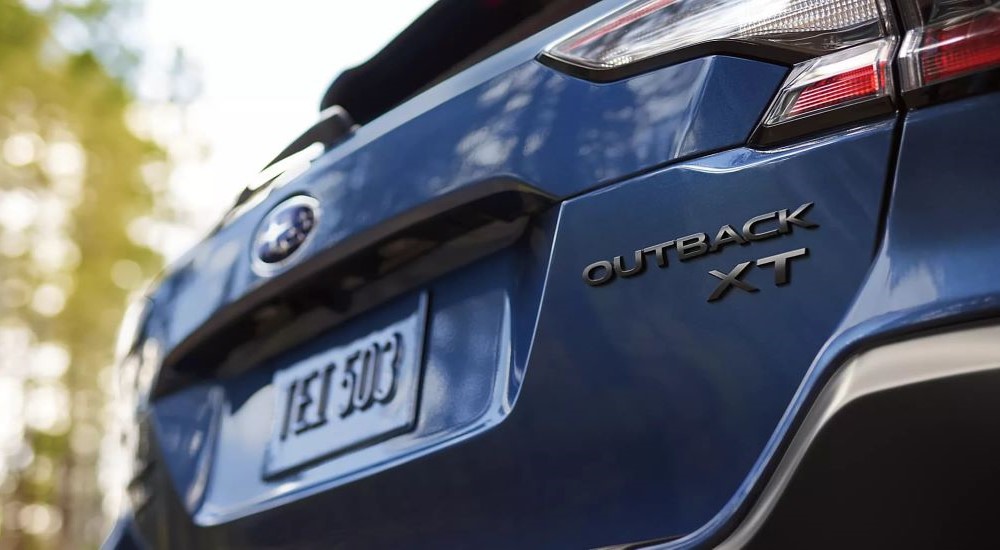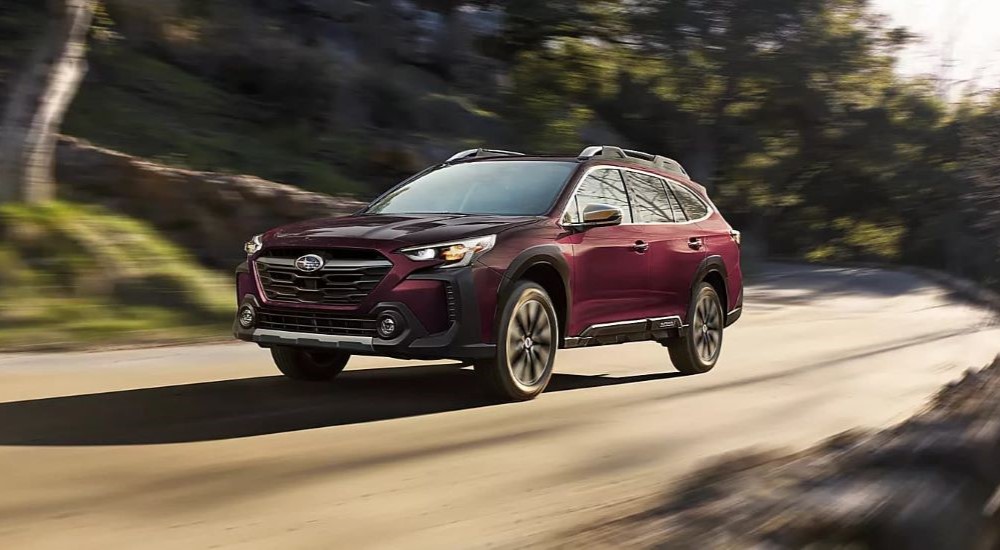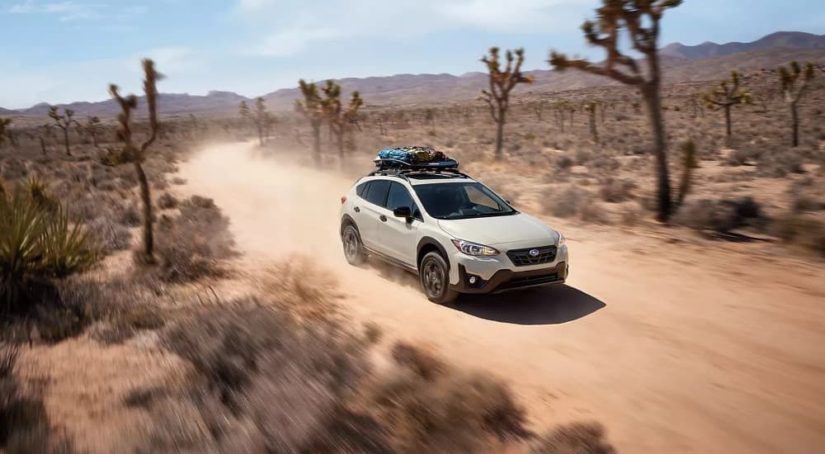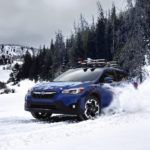Plenty of drivers will agree that the SUV market is getting a little wild. There are many SUVs out there, and sometimes it’s a little hard to tell which one is which, and why you might prefer one model over a similar model, even from the same manufacturer. Let’s say you’ve just arrived at your Subaru dealer, ready to get behind the wheel of a fantastic SUV. Should you choose the 2023 Crosstrek or the 2023 Outback? Is there a difference? Furthermore, how do you even decide whether you’re a subcompact, compact, or midsize SUV driver?
Technically speaking, both the Crosstrek and Outback are solid choices for drivers who are interested in all-wheel-drive vehicles that are comfortable stepping off the pavement now and again. They’re a little more rugged than the average SUV, with an exterior that reminds drivers more of the station wagon they grew up with than the colossal eight and nine-passenger behemoths that rule the roads today. As a result, they’re typically more economical. With several trims offered, they provide the features drivers want and need without falling short or offering too much for the average driver.
Let’s take a look at the Subaru Crosstrek and Outback side-by-side to determine which one may best fit your budget, life, and drivestyle.
A Brief Introduction to Subaru’s “Little Guys”
Of Subaru’s impressive SUV lineup, the Crosstrek and the Outback are some of the smallest in stature. The Forester and Ascent offer greater interior room, with the Ascent providing three rows of seating for larger families and adventure-seeking groups.
Each provides seating for up to five passengers, though the comfort of the middle passenger in the rear seat depends on the height of that passenger. Still, the 2023 Crosstrek boasts rear legroom of 36.5 inches, and the Outback treats rear passengers to 39.5 inches of leg space.
Both models are hatchbacks, allowing drivers to access the cargo area through a large rear hatch. Inside, Crosstrek drivers enjoy 20.8 cubic feet of cargo space with all seats occupied, or can fold down the standard 60/40 split rear seat to turn that into a cleverly configurable 55.3 cubic feet. In comparison, the Outback offers 32.6 cubic feet of cargo space behind its rear seat, or 75.6 cubic feet with the standard split folding rear seats tucked down.
Amazingly, the overall exterior size of the Crosstrek and Outback does not differ by feet, but mere inches. The Crosstrek stands 63.6 inches high and 176.5 inches in length with a 104.9 inch wheelbase. In comparison, the Outback has a height of 66.4 inches and a wheelbase of 108.1. The most notable difference is the Outback’s 191.1-inch length. While that explains the massive cargo potential, the extra length can be worth keeping in mind for drivers who are looking to navigate tight trails or urban spaces.

Power and Performance in the Crosstrek and Outback
The similarities continue to the Crosstrek and Outback’s engine options, but there are a few notable differences as well.
Subaru has placed its excellent 2.5L flat-4 engine in both of these models, but not necessarily as standard equipment. Most Crosstrek models enjoy a 2.0L flat-4 that provides 152 horsepower and 145 lb-ft of torque. Drivers who prefer more control can opt for a manual transmission with this version, as well. The Sport and Limited trims include the 2.5L version that cranks up to 182 horsepower and 176 lb-ft of torque, though the only transmission available is Subaru’s Automatic Lineartronic CVT. Incredibly, this engine gets the best overall fuel economy of the lineup, with 27 miles per gallon on the city streets and 34 miles per gallon on the highway.
The 2.5L flat-4 comes standard in many Outback trims, providing the same horsepower and torque, though fuel economy is dampened somewhat by the larger size of the vehicle. According to the EPA, the Outback equipped with this engine can expect 26 miles per gallon in the city and 33 miles per gallon on the highway. That’s still not dismal for the segment, but worth noting.
A turbocharged 2.4L flat-4 is included on the Outback XT models, as well as the Wilderness trim. Good for 260 horsepower and 277 lb-ft of torque, this model increases the towing capacity to 3,500 pounds, though the fuel economy dips to 23 miles per gallon in the city and 30 miles per gallon on the highway.
Special Considerations for Crosstrek and Outback Drivers Alike
While these are all certainly compelling differences between the two models, they might not be dealbreakers for many drivers. In fact, many drivers are more interested in “what’s included” over “how does it drive?”
Each model offers drivers a choice of trims, but the Crosstrek offers a more limited range of trims than the Outback. Crosstrek drivers can choose between Base, Premium, Sport, Limited, and Hybrid models, while Outback drivers can select between the Base, Premium, Onyx Edition, Limited, Touring, Onyx Edition XT, Wilderness, Limited XT, and Touring XT trims. In most cases, the differences lie in the features and sophistication of the all-wheel drive system, but there are a few notable exceptions.
If you are interested in a hybrid model, but not ready for the all-electric Solterra, may wish to consider the Crosstrek Hybrid. This model combines a 2.0L flat-4 with two electric motors, which can produce up to 17 miles of all electric range and a grand total of 480 miles of range on gas and electric combined. Not only does the Crosstrek Hybrid charge itself while you’re driving, but it can also be plugged into a standard household outlet to recharge. As there is no hybrid Outback model, this might be the most attractive Subaru model for eco-minded SUV drivers.
On the other hand, those who are interested in tackling the toughest trails may opt for the Outback Wilderness trim, which increases ground clearance to 9.5 inches, and includes an enhanced all-wheel-drive X-MODE with deep snow, sand, and mud settings,. It also features redesigned bumpers that improve approach and departure angles, and skid plates to protect vital drivetrain components.

Visiting Your Subaru Dealer
When it comes time to shop for your next Subaru SUV, it’s a good idea to stop by your local dealership to try these two models out for yourself. While knowing the basics is a great way to start the decision-making process, only you can tell for sure if the small details, like the way the air vents are angled, or the feel of the steering wheel in your hands, are right for you.
There’s really no wrong way to do a Subaru SUV, but your preferences do matter. Whether you’re looking for something that makes you feel a little extra confident in cold and slippery weather, or plan to thrash through the mud every chance you get, drivers trust Subaru SUVs for their standard all-wheel drive and innovative approach to driving. Whether you’re looking for the smallest possible model, or a model that makes sense for all of your many driving needs, both the Crosstrek and Outback can wear many hats without being large, overbearing vehicles.



